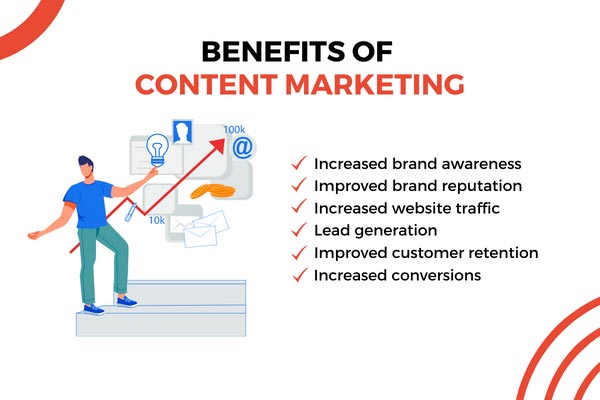
The Step-by-Step Guide to Content Marketing Mastery
Content marketing definition: What is content marketing?
Content marketing is a strategic approach to creating and distributing valuable and relevant content to attract and retain a clearly defined audience. The main goal of content marketing is to drive profitable customer action by providing useful information that helps people solve problems or address their needs.
It involves creating and sharing various forms of content such as blog posts, videos, infographics, social media posts, e-books, podcasts, and more. By providing valuable content to potential customers, businesses can establish trust, credibility, and authority in their industry, leading to increased brand awareness, customer loyalty, and ultimately, higher revenue.
What makes content marketing important?
With a potential global recession that is pressing the necks of many businesses, marketers have realised that spending more, not less, on their content marketing is a crucial business decision in 2023. The following are the statistics as per a survey conducted by Semrush.
- 97% of the businesses surveyed said they have generated positive results from content marketing — that’s a stunning number, up from 91% last year.
- 66% of companies have a defined content marketing strategy, up from 57% last year.
- 69% of all companies surveyed plan to increase their content marketing budgets in 2023.
- The five best-performing content formats were video, short-form articles, success stories, long-form blog posts, and case studies.
Through content marketing, businesses can build trust and credibility with their audience, establish themselves as thought leaders in their industry, and ultimately drive more conversions and sales.
In today’s digital age, where consumers have access to an overwhelming amount of information, content marketing helps businesses cut through the noise and connect with their target audience in a meaningful way.
By creating high-quality content that meets the needs and interests of their customers, businesses can establish a loyal customer base and achieve long-term success.
Positive outcomes of content marketing
Here are some benefits of content marketing:

- Increased brand awareness:
Creating and publishing content that is valuable and relevant to your target audience helps increase your brand’s visibility and reach. - Improved brand reputation:
By consistently delivering valuable content that helps your audience solve problems, answer questions, or entertain them, you can build trust and establish your brand as an authority in your industry. - Increased website traffic:
Publishing quality content that answers your target audience’s questions and provides value can drive more traffic to your website. - Lead generation:
Content marketing can be an effective way to generate leads by offering valuable resources in exchange for contact information. - Improved customer retention:
By providing helpful content that meets your audience’s needs, you can build a relationship with them, leading to increased loyalty and repeat business. - Increased conversions:
High-quality content that provides value can also help drive conversions by influencing purchasing decisions.
Overall, content marketing can be an effective way to build a relationship with your target audience, establish your brand as an authority, and drive profitable customer action.
The mechanics of content marketing
You can use content marketing to showcase your products or services to your potential clients when they search for the products or services that you sell.
Your potential customers fall into different stages of the sales funnel –awareness, consideration and conversion – and the type of information they require differ from state to stage. To reach to your customers, you need to deliver the right content that suits to each buying cycle of your potential audience.
Here’s how companies use content marketing in each stage of the sales cycle to engage and sell.
Awareness stage
In the awareness stage, your goal is to create content that educates and raises awareness about the problem that your product or service solves. Here are some tips on how to do content marketing for the awareness stage of the buying cycle:
Identify your target audience
Understanding your target audience’s pain points, interests, and behaviours will help you create content that resonates with them.
Develop content that educates
Create content that educates your audience about the problem that your product or service solves. For example, you can create blog posts, infographics, newsletters, e-books, videos, or social media posts that highlight the importance of solving the problem.
Use visual content
Visual content such as images, videos, and infographics can help break up large chunks of text and make your content more engaging.
For example,
- a company that sells camping gear might create blog posts that offer tips on how to choose the right tent, how to pack for a camping trip, or how to stay safe while hiking.
- a healthcare company might create an infographic that explains the benefits of exercise or the dangers of smoking.
- a beauty brand might create social media posts that showcase different makeup looks or offer beauty tips.
Consideration stage
Content marketing in the consideration stage is focused on providing potential customers with information that helps them evaluate their options and make an informed decision. Some of the strategies you can use are:
- Provide educational content that explains the features, benefits, and limitations of your product or service;
- Showcase real-life examples of customers who have used your product or service to solve their problems. Use case studies, testimonials, and reviews.
- Compare your product or service with similar offerings in the market.
- Provide potential customers with the opportunity to try your product or service for free through free trials or demos.
- Use retargeting ads to remind potential customers about your product or service after they have visited your website.
Closing stage
At this point, your content should focus on providing reassurance and confidence to the buyer that they are making the right decision. This may include creating targeted landing pages, offering special promotions or discounts, providing product demos, and using customer testimonials to build trust and credibility.
Examples:
- Sharing testimonials and case studies of satisfied customers can be a powerful way to close a sale.
- Limited time offers and promotions creating a sense of urgency can be an effective way to encourage prospects to act and make a purchase.
- Providing a demo or free trial can be a great way to give prospects a hands-on experience with your product or service.
Tips for starting your content marketing strategy
Content marketing does not need to be complicated. Once you understand the underlying concept, you can devise successful and simple strategies. Go through the following steps to get started.

Determine your target audience
Use online tools, surveys, interviews, and focus groups to gather information about your target market.
Analyse your website and social media analytics to gain insights into who is already engaging with your content. This will help you understand what content is resonating with your existing audience and how you can create more of it.
Develop detailed profiles of your ideal customers based on the data you’ve gathered. This will help you create more targeted and personalised content that speaks directly to your audience.
Identify the appropriate formats
This depends on several factors, including your target audience, the message you want to convey, and the goals of your content marketing campaign.
Some steps you can take:
- Identify your target audience and what types of content they prefer to consume. For example, if your audience is primarily made up of visual learners, you might want to consider using more images, videos, or infographics.
- Determine the goals of your content marketing campaign. Are you trying to generate leads, increase brand awareness, or drive sales? The format of your content will depend on your goals.
- Think about the message you want to convey to your audience. Some messages are better suited to certain formats than others. For example, a complex topic might be better conveyed through a white paper or an eBook, while a quick tip or hack might be better suited to a social media post.
Figure out the best way to distribute
When coming to distributing the content, take these factors –audience, content type, goals and budget—into consideration.
Audience
Consider where your target audience is hanging out. Are they active on social media? or do they prefer a professional network site like LinkedIn? This will help you determine which platform to prioritise.
Content type
Consider the type of content you are creating. For example, if you are creating videos, you may want to distribute them on platforms like YouTube or Vimeo. If you are creating long-form written content, you may want to distribute it on your blog.
Goals
Identify your goal, whether it is to increase brand awareness, generate leads, or drive sales? Different distribution channels may be more effective at achieving different goals.
Budget
Understanding your budget will help you determine which channels are most feasible.
Choose a realistic schedule
After identifying your target audience and determining the optimal formats for each phase of the sales process, formulate a short-term plan that spans three to six months. Be cautious of creating a content marketing strategy that is too ambitious, instead aim to design a plan with content components that can realistically be produced based on your available budget and resources. Keep a record of the time required to generate each piece of content, so that you can factor it into your schedule.
Follow best practices
Inspiring content looks simple and free of jargons. It should also include detailed how-to advice. A short, relevant, motivating piece of content is the best.
SEO and content marketing
SEO and content marketing are closely intertwined, with SEO playing a significant role in the success of content marketing efforts. SEO helps content marketers to optimise their content for search engines and improve their visibility in search results, driving traffic and potential customers to their website.
By understanding the keywords and phrases that their target audience is searching for, content marketers can create high-quality, relevant content that aligns with their audience’s interests and needs.
Additionally, SEO can help content marketers track their content’s performance, identify areas for improvement, and adjust their strategy, accordingly, leading to more effective content marketing campaigns.
Few SEO Tips:
- Use keyword research tools to identify relevant keywords that your audience is searching for. Include those keywords naturally in your content, including the headline, subheadings, body copy, and meta tags.
- Your headlines should be attention-grabbing, relevant, and include your primary keyword. Avoid click-bait headlines that don’t accurately reflect the content of your article.
Social media and content marketing
Social media and content marketing are two highly interrelated strategies that work together to increase brand visibility, engagement and sales.
Content marketing involves creating and sharing valuable, relevant and consistent content to attract and retain a clearly defined audience.
Social media, on the other hand, is a platform that enables businesses to distribute and promote their content to a wider audience, engage with customers and build relationships. By combining the power of content marketing and social media, businesses can create a strong online presence.
Effective content marketing on social media requires a deep understanding of the target audience and the ability to create compelling content that resonates with them.
Leave the heavy lifting to us and enjoy the benefits of our expertise.
Faye Digital is a full-service digital marketing agency based in Melbourne, Australia. With years of experience helping businesses of all sizes achieve their goals, Faye Digital is the partner you can trust to help you navigate the ever-changing digital landscape. So why wait? Check out our services today to learn more about how we can help your business grow!
